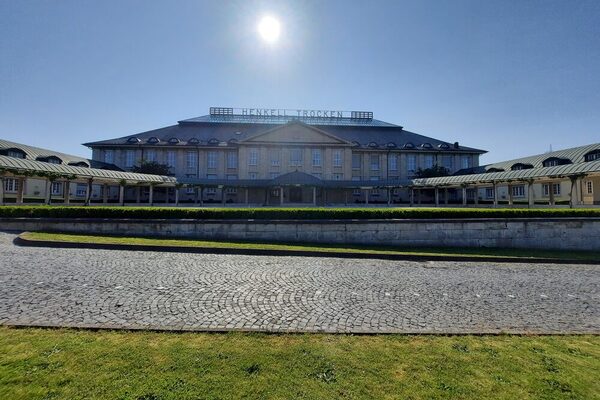Henkell & Co., sparkling wine producer
Adam Henkell (1801-1866) began producing sparkling wine in Mainz in 1856. He had founded the wine export company Henkell & Cie with a partner in 1832. The success of the sparkling wine brand Henkell Trocken meant that the company's headquarters in Mainz became too small. It was created in 1894, trademarked in 1898 and sold so successfully at the turn of the century that the 50 small wineries in Mainz urgently demanded a more generous solution. By 1906, three million bottles had already been produced. Otto Heinrich Adolf Henkell, the grandson of company founder Adam Henkell, had the new production facility built in Biebrich on Biebricher Allee, which was still independent at the time, according to plans by architect Paul Bonatz. The building, one of the most modern sparkling wine cellars in Europe, was inaugurated on November 27, 1909.
The generosity of the client and his architect is reflected in the architecture of the neoclassical building, which combines elements of Greek and Roman antiquity as well as Baroque and Classicism. Ultimately, the three-winged building, with its borrowings from baroque palace architecture, combines the needs of both stately representation and modern industrial production. Since the building was erected, the technology has been constantly updated. The method of disgorging, the manual removal of the yeast from the bottles, has long been carried out by fermentation in air-conditioned stainless steel vats. The historicizing façade of the Bonatz building gave the new fashionable drink sparkling wine an aura of tradition right from the start. The painting of the strictly classicist marble hall in the rococo style did not take place until the end of the 1920s.
Otto Heinrich Adolf Henkell relied on consistent advertising for the brand product from the very beginning. In 1904, the "advertising budget" for Henkell Trocken amounted to 100,000 marks. Henkell hired the best illustrators of his era, including Thomas Theodor Heine and Olaf Gulbransson, who were known for their sharp-witted political caricatures. The witty motifs appeared in "Simplicissimus" and "Jugend".
Karl Henkell had been a partner in the company alongside his brother Otto since 1911. From 1935 onwards, Henkell & Co. also produced small bottles under the name "Pikkolo". It became synonymous with sparkling wine in quarter bottles. Today, Henkell Trocken is exported to over 70 countries around the world.
In 1948, Otto Hubertus Henkell, son of Karl Henkel, took over the management of the company. Sektkellerei Henkell & Co., which merged with Schiersteiner Söhnlein Rheingold AG in 1987, ultimately developed into a Central European supplier of sparkling wine, wine and spirits. After the merger, the company continued as Henkell & Söhnlein Sektkellereien KG and since 2009 as Henkell & Co, Sektkellerei KG.
The Henkell Group is present in ten countries, from France to the Ukraine. In 1960, the company entered the vodka Gorbatschow business, and in 1975 Henkell & Co. took over Sektkellerei Carstens KG in Neustadt an der Weinstraße. In 1987, Hungarovian AG, the Hungarian market leader for sparkling wine, was incorporated, followed by Kurpfalz Sektkellerei AG in Speyer in 1995. In 1996, Henkell & Söhnlein Polska was founded in Warsaw. In 1997 Henkell & Söhnlein took over Deinhard AG in Koblenz, and in 1999 the qualified majority of shares in Bohemia Sekt in the Czech Republic. Other companies such as the sparkling wine manufacturer Menger-Krug in Deidesheim and the brands Kupferberg Gold and Scharlachberg Meisterbrand were acquired in the following years, as was a beverage group in Romania.
Hans-Henning Wiegmann has been spokesman for the management of Henkell & Co. Sektkellerei since 1992. In 2015, the Henkell Group's annual turnover amounted to €689.1 million.
Literature
Henkell & Co, Sektkellerei KG. A group of companies introduces itself, Wiesbaden 2011.

